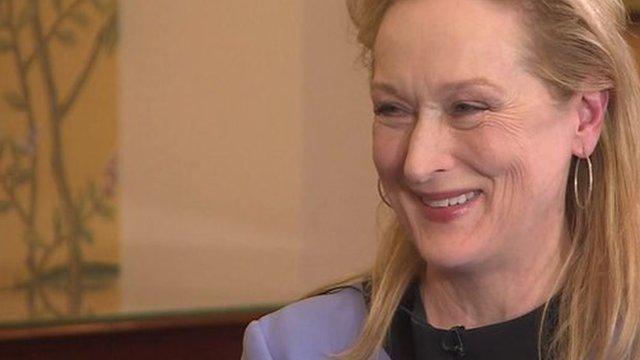Can F-rated films help overcome sexism in Hollywood?
- Published

Cate Blanchett has berated Hollywood for believing films about women are 'niche'
The inequality between men and women in the film industry has been brought into sharp focus by stars like Jennifer Lawrence, Geena Davis and Cate Blanchett. Could a new F rating - for films made by or with major roles for women - help close the gender gap?
Here are some facts about the film industry:
One of the top 100 grossing films of last year in the US was directed by a woman. [Source, external]
Women had less than a third of speaking parts in the most popular films last year. [Source, external]
Of the most successful 100 films of 2014, 12% had female protagonists. [Source, external]
On the biggest films of the last 20 years, 77% of crew members were male. [Source, external]
And as Jennifer Lawrence found out, actresses usually get paid less than men.
Everybody knows the film business has a problem.
A-list stars like Cate Blanchett, who used her 2014 Oscars acceptance speech to point out films about women are not "niche", Geena Davis, who set up her Institute on Gender in Media, and Jennifer Lawrence, who penned an essay about unequal pay, have made sure of that.
But it is perhaps only when those facts are spelled out that it becomes clear quite how far the scales are tipped.
Thanks to those actresses, among others, it also feels like there might finally be sufficient pressure for things to change. But it is not just big names who are pushing for progress.

Jennifer Lawrence learned via leaked Sony emails that she earned less than her male co-stars
Last year, the Bath Film Festival wanted a way to highlight the gender gap and give film fans a way of choosing films that represented some kind of equality.
So festival director Holly Tarquini came up with the F rating to sit alongside a movie's usual age classification.
It is given to any film that meets one of three criteria: It must be written by a woman, directed by a woman or feature "significant women on screen in their own right".
Statistics about the female representation in the film industry "felt so far away from any kind of equality", Tarquini says.
"We wanted to highlight what women were doing because there are fantastic female writers and directors and there are amazing stories about women on screen.
"But they tend to have lower budgets and be given less for promotion. So we developed the rating as a way of trying, in our own small way, to redress the balance."

Room, starring the Oscar-tipped Brie Larson (right), opened the Bath Film Festival
The F rating is a fairly blunt instrument and is not meant to guarantee whether the film is any good, or whether it might appeal to female audiences.
Instead, Tarquini compares it to the Fairtrade stamp on groceries. "The F rating gives audiences a way to vote with their feet," she says.
"Much as the Fairtrade rating allows you to look at two different coffees and think, I'll buy the one that supports farmers, the F rating gives people the ability to look at two films and say: 'Let's go and see the F-rated one because that supports women in film'."
At the latest Bath Film Festival, which began on Thursday, 40% of the line-up carries the F rating, up from 33% last year.
Qualifying films include Room, adapted by Emma Donoghue from her own Booker Prize-nominated novel; The Assassin, about a young Taiwanese female killer, which was recently voted the best film of 2015 by film critics; and Grandma, about a young woman who asks her grandmother for money for an abortion.

The Assassin, which stars Shu Qi, has been hailed as the year's best film
In Sweden, instead of an F rating, between 20 and 30 cinemas now use an A rating, which is given to films that pass the Bechdel Test.
The test is named after US cartoonist Alison Bechdel, who had a character who only went to see a film if it contained two women who talked to each other about something other than a man.
The A rating was introduced two years ago by Ellen Tejle from Stockholm's Bio Rio cinema, who spoke about the issue at the This Way Up cinema conference in Manchester this week.
Tejle says producers and distributors were not interested in using the A logo - until research suggested films that passed the test earned more at box offices than those that did not, external.
"Then after one month they emailed me and said: 'Is it OK if we put [the logo] on?'." Tejle says. "And scriptwriters have sometimes emailed me two pages from their script and said 'Is it OK? Can we use it?'"
Money clearly talks. The A rating is just a "first step" toward making people aware of the problem, Tejle explains.
"I hope that after two years more people are aware of this gap and know to change their way of seeing films, or change their way of doing films. And we can see that people are doing that."
Back in the UK, since last year's Bath Film Festival, more than 20 independent cinemas and festivals have adopted the F rating.
'Makes people think'
They include Queens Film Theatre in Belfast, whose programmer Michael Staley hopes using the F stamp will cause fans to ask questions about the issue.
"If they get used to seeing that F-rated symbol beside films, it might make people think more about that inequality," he says.
"I imagine it will be refined in some way in terms of the criteria, but at the minute I see no reason not to do it."
Other cinemas are waiting for that refining to take place. Madeleine Probst from Bristol's Watershed suggests a rating or seal of approval could be given to each cinema rather than each film.
"I'm really interested in the Bechdel Test because it's a great way of creating a conversation," she says. "Rating all our films with an F or another letter is something I'm still to be convinced is the way forward."
Independent cinemas may be open to the idea, but big chains, which run the vast majority of screens, are not likely to be displaying the F symbol soon.
Phil Clapp, chief executive of the UK Cinema Association, says: "The vast majority of our members would find such a blunt 'quality stamp' unattractive, not least in that the suggested approach would exclude a large number of films which are about women and/or which promote gender equality, while including others which are unarguably less sympathetic to that agenda.
"As a result, this is something few cinema operators would wish to involve themselves in, the general sense being that it's not the way forward on these issues."
- Published29 October 2015

- Published15 October 2015

- Published13 October 2015

- Published12 October 2015

- Published9 October 2015

- Published8 October 2015
